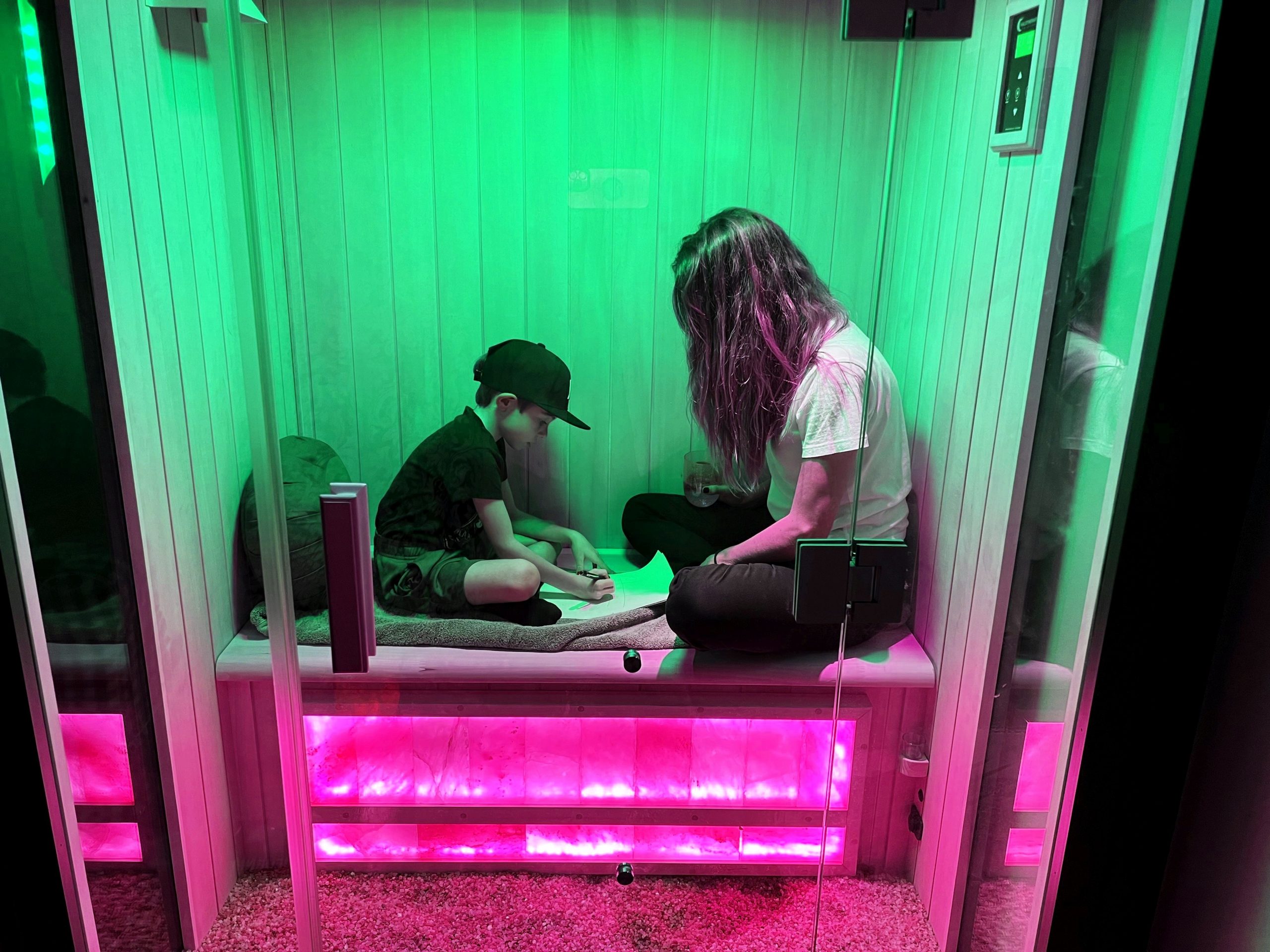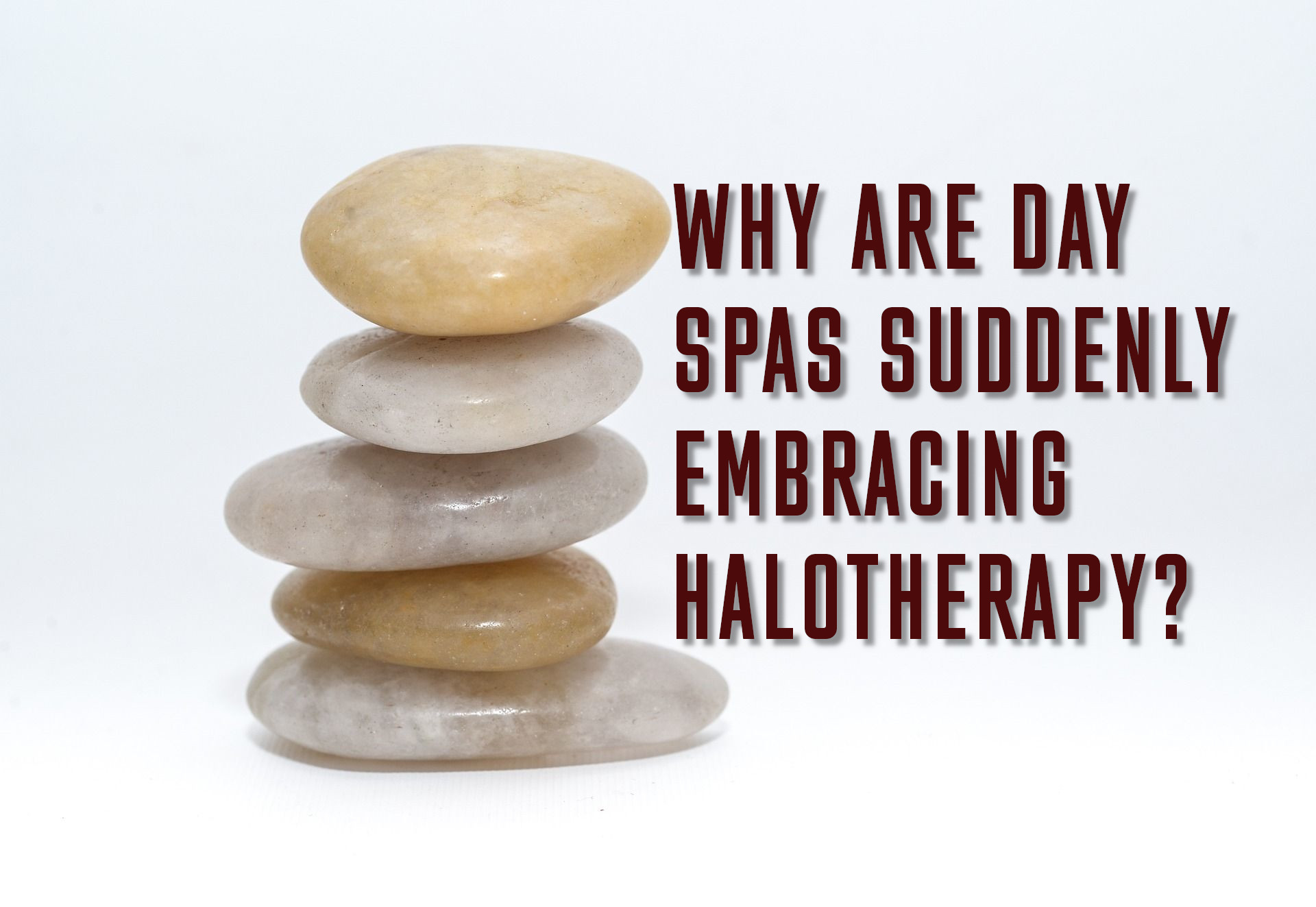Halotherapy is a holistic therapy involving microscopic salt in an enclosed area also referred to as a salt den or salt chamber. There’s currently a lot of hype around halotherapy salt chambers in day spas and holistic wellness centers. Salt therapy is touted to offer users a list of health benefits including respiratory relief and skin rejuvenation.
Additionally, relaxation and a sense of well-being are reported by salt therapy enthusiasts. Unfortunately there’s not a whole lot of scientific proof to back up these claims. However, that doesn’t mean halotherapy doesn’t deliver, it just means we need to be patient for more studies to be conducted. In the mean time we can base our evaluations on anecdotal claims, and those are mostly very promising. While may be an absence of proof from large studies, there are already a large number of hardcore believers. Particularly those with asthma and other breathing conditions, as well as biohackers.
Some halotherapy goers have made salt therapy a part of their daily health maintenance protocol.
Intro to Halotherapy

Halotherapy is a type of salt therapy that some people assert is advantageous for breathing as well as helping to heal and manage skin problems. Halotherapy and speleotherapy are similar in that they both utilize micronized salt particles entering the lungs.
Salt therapies have a long background of use in some parts of the globe, such as Eastern Europe, and they are only currently picking up steam in the United States. It’s becoming obvious we’re on the verge of a major salt therapy trend here in America. My favorite local day spa offers Halotherapy in Long Beach California, they recently installed their first salt therapy system and it’s amazing. Look for halotherapy popping up in your city soon, if it’s not already there.
The salt therapy boom in Southern California could certainly be a solid predictor that halotherapy is on the rise everywhere. Pharma-grade salt is finely ground and heated in a halogenerator, a machine for grinding up salt. The microscopic salt particles are sprayed into the room consistently, so fresh salt is always permeating in the salt room. The micro-salts are naturally breathed in while you’re in the room. No extra steps are required, just try to relax and breathe deep.
The salt in your lungs helps break up mucous as well as eliminate microorganisms within the cardiovascular system. For those having trouble breathing salt therapy is reported to help open up and relax the lungs. It may also serve as a vasodilator by increasing blood flow throughout the body.
Beyond breathing better, halotherapy is reported to improve skin conditions and irritations attributed to disease and/or environmental factors. This article is intended to give you the low down on halotherapy, as well as some reported benefits observed by users. We’ll look at research too, but as I mentioned earlier we’re hoping for additional studies to back up the anecdotal results we’ve heard about so far. I also want to look at potential adverse effects. Could there be some unwanted salt therapy side effects? Read on to find out.
The most commonly touted benefits of salt therapies are listed below. Keep in mind these may or may not be true. Everyone’s experience is unique.
- Relief from bronchial issues such as athsma
- Skin softening and smoothing
- Reduction of symptoms of some skin conditions
- Increased sense of happiness and well-being
- Relaxation and reduction of stress
Origins of Salt Therapies
Salt therapy caves are super common in Europe and Russia and is just recently catching on in the USA. Documented salt therapy history has been reported as far back as 1839 as a therapeutic approach to medical conditions. Even before that salt mining workers in salt caves were observing health benefits from breathing the salt filled air. Nonetheless, the therapies are less common in the U.S. Salt therapy benefits have been documented as far back as the early 1800s when a Polish physician noticed that salt mining employees had lower instances of respiratory disease than the general public.
Later, similar health benefits were noted by a German physician. He noted that those hiding in salt caves during WW2 appeared to be less likely to experience respiratory diseases than others in the same area. It could be said that people hiding in salt caverns as a means of survival unintentionally led to the discovery of astonishing health benefits. A more commercial offering of halotherapy became available in the 1950s as these therapies made their way into health spas and wellness centers. Despite lacking scientific evidence the therapy was gaining popularity and acceptance as a luxurious health treatment.
Types of Dry Salt Therapies
Halotherapy
Halotherapy and Speleotherapy are two types of dry salt treatments. Halotherapy is a man-made version of the speleotherapy environment. Halotherapy takes place in enclosures fabricated to house the salt filled environment. A halogenerator is used to finely grind salts into a microscopic powder. The salt powder is breathed by participants in order to receive salt therapy benefits. Halotherapy salt dens can be found in spas and health centers. Health Spas that offer halotherapy use a dry salt aerosol to spread out small fragments of salt around the area via a halogenerator. Halotherapy is often combined within an infrared sauna. Health spas offering infrared sauna therapy often also provide salt therapies, often in a combined enclosure.
Speleotherapy
Speleotherapy was first discovered in 1843 and takes place in naturally formed salt caves under ground. Salt caves can be found in various locations around the world. Rather than seek out a cave for salt therapy benefits, most people choose halotherapy. Halo Therapy makes use of an artificial environment to produce the very same results as speleotherapy. In Eastern European countries speleotherapy is provided to citizens as a part of their health care system.
Speleotherapy is not viewed as a legitimate medical treatment in most countries around the world. In some parts of the world salt therapies have been common practice for over 50 years or more. Speleotherapy still lacks major studies, so in the United States salt therapies aren’t generally recognized as a legitimate medical treatment. Therefore, it is commonly categorized as a luxurious spa treatment. In the USA, relaxation and mood control are the main benefits attributed to salt therapies. Germany experienced a significant boom starting around 2001. As a result of it’s popularity, speleotherapy studies were conducted in children, producing favorable medicinal results.
Salt Therapy in Biohacking
The current halotherapy boom in popularity can be directly linked to the current trends in biohacking. In addition to the touted medical benefits of these therapies, many people are seeking self-optimization aka biohacking benefits. Biohackers claim to use treatments, rituals, herbs, meditation practices, to name a few, to increase their abilities and capabilities as a human being. Some biohacking experts report benefits from halotherapy such as:
- Increased mental clarity
- Improved concentration
- Reduced depression
- Improved balance
- Improved cardiovascular performance
These biohacking benefits of halotherapy are hard to prove but shouldn’t be dismissed. It is widely accepted that many biohacking benefits are believed to be a placebo effect. If scientific research is lacking, yet users report noteworthy benefits my stance is that’s a net positive result.
Salt Therapy Minerals
- sodium chloride
- manganese
- calcium
- sulfates
Energetic salt areas utilize a salt generator to spread out the salt around the area. Easy salt areas consist of big amounts of salt in the space without a generator to relocate around. The Salt Therapy Organization (STA) suggest that easy salt areas are not a form of halotherapy. Nonetheless, they can still be kicking back and also boost an individual’s feeling of wellness.
Respiratory System
The respiratory system could possibly benefit from salt therapy in the following ways:
- Increasing short-term lung capacity, hence clearing the lungs
- Clearing pollens, contaminants, as well as viruses from the lungs and nasal tracts
- Opening nasal cavities as well as blocked sinuses
- Reducing inflammatory conditions
- Soothing and even reducing skin issues
Nevertheless, these beliefs are mostly anecdotal and there is little scientific evidence to back up these claims. I’m optimistic we’ll see some large-scale studies in the next few years. It should be noted that large studies will likely require independent financial backing because there is not a drug intervention involved, only salt. This means the FDA and other large government entities have very little interest in looking into the efficacy of salt treatments. Larger studies are likely to be conducted by the major salt therapy manufacturers such as Spiritual Quest to prove their proclaimed benefits and further increase popularity of such therapies.
Salt Therapy for Specific Breathing Problems
Some people think that salt treatments have advantages for breathing problems, such as asthma. Nonetheless, research study around is still lacking. The adhering to sections will certainly lay out the existing research study in a lot more detail.
Chronic Obstructive Pulmonary Illness (COPD)
Some medical experts have actually recommended that halotherapy may benefit chronic obstructive pulmonary condition (COPD). 35 COPD patients using a dry salt inhaler during a 2007 COPD salt therapy study showed improvement in the six-minute walk test and showed an increase in quality of life. Another study conducted in 2014 suggested halotherapy provided a no notable improvements in COPD patients. With conflicting information from one study to another the most sensible approach for those affected by COPD is to use their best judgement. The downsides appear to be minimal meaning salt therapy could be worth a try for those with COPD.
Respiratory Infection
To date, there’s no hard medical evidence that salt therapy works for stopping infections such as COVID-19. The Centers for Disease Control and Prevention (CDC) haven’t released any endorsements or protocol to encourage the use of salt therapies to aid with COVID-19 infections. On the other hand, CDC hasn’t outright discouraged halotherapy for Covid-19. Salt therapy should be viewed more as a potential symptom reducer for Covid-19, rather than a cure. Covid-19 starts in the nasal cavity and lungs, making it a respiratory infection. It stands to reason that halotherapy could reduce early signs of Covid. The treatment could be promising in managing symptoms but you should talk to your doctor before using halotherapy treatment for Covid-19.
Bronchiectasis
In an attempt to find long term relief bronchiectasis many Europeans have resorted to salt therapies. While the halotherapy and speleotherapy have been widely reported to have helped many people, large studies are needed to confirm efficacy. Short term relief is a more common report, as opposed to halotherapy being touted as a cure for bronchiectasis. In one salt therapy study in 2013, more than 60% of the participants said they definitely saw at least minor improvements in their condition. This may be a placebo effect which is very common in holistic rituals and treatments. Under safe circumstances a placebo effect producing a positive outcome is still certainly desirable. The positive results reported could simply be a result of participants feeling relaxed and stress free in salt dens.
Bronchial Asthma
In a rodent study in 2014 recommended that salt therapy might help bronchial asthma. A micronized salt environment was created for the rodents and they showed improvement in breathing. However, according to the writers of a major 2001 study, there is little evidence for the benefits of speleotherapy on asthma.
Adenotonsillar Syndrome
In a 2013 trial, researchers provided 45 people with adenotonsillar syndrome either 10 halotherapy sessions or a placebo. After the test, individuals receiving the halotherapy revealed some renovations in their signs and symptoms.
Halotherapy Risks and Safety
There’s currently no federal standardization for halotherapy in the U.S. although each state could eventually implement standards of practice. The halogenerator salt machines currently used on the market range in size and capacity and are generally considered safe when operated correctly. Only salt or saline solution should be used in halogenerators unless otherwise specified by the ma. Although not severe, coughing is sometimes induced by halotherapy. With limited research additional side effects can’t be totally ruled out. Salt therapies are widely accepted as a risk-free means of balancing restricted breathing for many people. In my halotherapy research I haven’t discovered any reports of medical emergencies involving these therapies.
While it’s stated to treat breathing problems and restricted airways, halotherapy could possibly irritate the throat if a person is overexposed to the salt filled air. This can cause coughing or wheezing during a prolonged salt therapy session. Some people also report obtaining headaches throughout halotherapy. Of those reporting headaches, the majority of people say it’s only mild and subsides shortly after their session. Halotherapy is pure and natural meaning it’s not likely to cause any adverse interactions with medications or other spa treatments. Talk to your health care professional if you have specific concerns about salt therapy interactions with medicines. Supporters of halotherapy claim it’s risk-free for kids and expectant females. Nevertheless, there’s little research study to support this claim. According to a 2008 research, inhaling a 3 percent saline solution is a risk-free as well as reliable therapy for infants with bronchiolitis. Nevertheless, . The quantity of salt carried out can differ greatly.
Alternate Salt Therapies
An alternate way to use salt for certain wellness problems is wet salt therapy. This consists of making use of:
- neti pots
- saline solutions and sprays
- nebulizers
- sea salt exfoliation scrubs
- floatation tanks
- salt baths
- swishing salt solutions
Some people make use of wet salt therapy for respiratory problems, consisting of the common cold. Others use it for beauty therapies and to boost skin health. The therapy is also relaxing and can be valuable for improving basic wellness.
Recap on Halotherapy
As detailed above, there’s promising feedback suggesting halotherapy could help reduce some breathing problems. The frustrating issue is there are so few large-scale studies at this point. This leaves me inconclusive as to whether I can strongly recommend halotherapy at this point. As of this writing I can say with some degree of certainty that enjoying a salt den at your local spa could be a harmless and relaxing treatment. If there are potential adverse effects, they don’t seem to expand beyond coughing.
Although the jury is still out on this treatment being a medical miracle it can be a way to chill and even meditate in a mellow and quiet environment. Anything which can give me a sense of piece and relaxation gets a thumbs up from me. After all, self-care should not be forgotten or overlooked. As with any relatively unproven treatment it’s always a good idea to talk with your health care professional before you try it. During my research on halotherapy for this article I haven’t discovered and nationally accredited certifications or degrees related to administering salt therapies. This means I’ll be putting my trust in my neighborhood day spa’s staff to follow the best known practices and also use only pharmaceutical grade salts. Happy salting!






